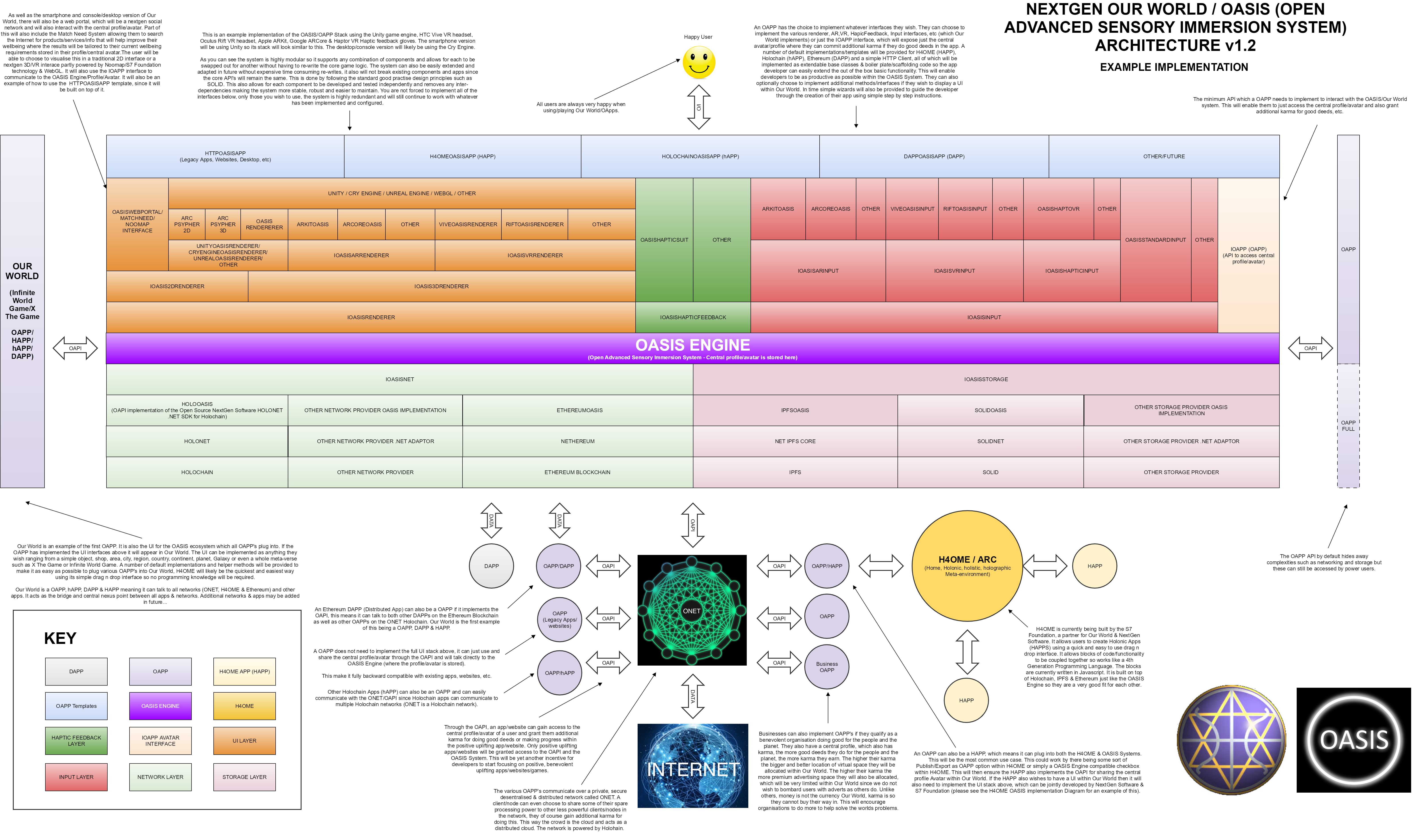Behold, we give you the OASIS…
Our World will run on our own propriety game engine called OASIS 2.0 (Open Advanced Sensory Immersion System).
Our World will run on a secure, distributed and de-centralized architecture where user’s data will be stored on their machine and not a central server enabling the user to own their data, meaning it cannot be sold or exploited as others do. It will do this by running on a new nextgen Internet known as Holochain.
Our World will run on its own private secure network called ONET (OASIS Network) on top of HoloChain offering yet more security and performance benefits. It will not suffer from any bottlenecks as is the case with the current centralised server architecture in current games causing lag, which is very frustrating to gamers and can mean life or death in games.
Our World/OASIS & ONET can even distribute the computing power across the gamers machines so if some machines are struggling, they can borrow processing power from fellow gamers with more powerful rigs (if they give permission of course!). Sounding like the OASIS from Ready Player One (book version) yet? 
It will also run on IPFS, the Ethereum blockchain, DAOStack ARC & H4OME.
Our World is also a HApp (H4OME App), a HoloChain App & a DApp (Ethereum Distributed App), SOLID app implementing all of their respective interfaces.
It will also allow any HApp, HoloChain App, DApp, SOLID App to plug into Our World where they can share their data (as well as connect to the central avatar/profile) or even their full UI within the Our World VR/AR/XR/IR (Infinite Reality) world/universe. It will also allow any other legacy apps/games/systems to plug in using a HTTP API that implements the OAPI (OASIS API). It will act as the bridge between all the upcoming nextgen technology as well as supporting legacy systems until they are also migrated to the new nextgen internet
All of these apps that plug into the OASIS Engine (Our World) will be known as OApps (OASIS Apps). As well as these OApps being able to share their data/UI with any other OApp, they can also take advantage of the OASIS Asset Store where users can buy various add-ons for your app/game.
By supporting everything Our World/OASIS will help act as a bridge between the old and the new world.
NextGen Software & Our World themselves will also be a DAO (Distributed Anonymous Organisation) registered with DAOStack meaning we can self-govern and cut out the expensive middlemen such as banks, lawyers, accountants, managers, contracts etc. This technology will allow us to realise our long-held dreams of running a flat decentralised organisation where every voice is heard, respected and is counted as an equal. This also prevents fraud, mistakes and corruption from occurring as is all too common now days.
NOTE: The design is evolving all the time so the above is subject to change…
Open Modular Design
As you can see from the diagram the OASIS architecture is very modular, open and extensible meaning any component can easily be swapped out for another without having to make any changes to the rest of the system. It will use MEF (Managed Extensibility Framework) so the components can even be swapped out without having to re-compile any of the existing code, you simply drop the new component into a hot folder that the system will pick up on the next time you restart.
The components are split into 11 sub-systems/layers:
- Storage (IOASISStorage Interface)
- Network (IOASISNET Interface)
- Renderer (IOASIS2DRenderer & IOASIS3DRenderer Interfaces)
- XR/Eye Tracking
- Haptic Feedback
- Realtime Emotional Feedback System
- Face Recognition
- Motion Tracking
- Input
- OAPP Templates
- OASIS Engine/API
Currently HoloOASIS implements the IOASISStorage interface. In future it will also implement the IOASISNET interface.
PLEASE MAKE SURE YOU READ THE DESCRIPTION BOXES ON THE DIAGRAM FOR MORE INFO ON HOW THE SYSTEM WILL WORK.
NOTE: This is still a WIP, so the above is likely to evolve and change as we progress…
Our World/OASIS Will Act As The Bridge For All (Legasy, IPFS, Holochain, Ethereum, SOLID, Fediverse, Mastodon, Diaspora, WebFinger, ActivityPub, XMPP & More!)
As you can see from the architecture diagram, the system will act as the bridge for all platforms and devices due to it being very open and modular by design. In future there will be support for IPFS, Ethereum, SOLID, Fediverse, Mastodon, Diaspora, WebFinger, ActivityPub, XMPP plus many more. This will help users of both legacy apps/games/websites and blockchain slowly migrate to holochain since it will help expose it to them all. The OASIS API will act as a stepping stone as well as help Everything talk to Everything for maximum compatibility.
Goodbye silos and walled gardens, hello full integration through ONE universal unified interface!
Implement Your Own Storage/Network/Renderer Provider
Thanks to the system being very open/modular by design you can easily implement your own Storage/Network/Renderer Provider by simply implementing the IOASISStorage / IOASTNET / IOASIS2DRenderer / IOASIS3DRenderer interfaces respectively. For example you could create a MongoDB, MySQL or SQL Server Storage Provider. This also ensures forward compatibility since if a new storage medium or network protocol comes out in the future you can easily write a new provider for them without having to change any of the existing system.
The same applies if a new 3D Engine comes out you want to use.
Switch To A Different Provider In RealTime
The system can even switch to a different Storage/Network Provider in real-time as a fall-over if one storage/network provider goes down for example. It could even use more than one Storage/Network provider since certain providers may be better suited for a given task than another, this way you get the best of both worlds as well as ensure maximum compatibility and up-time.
The same applies for the Renderer Provider, it could use one provider to render 2D and another for 3D, it could even use more than one for for both 2D and/or 3D.

